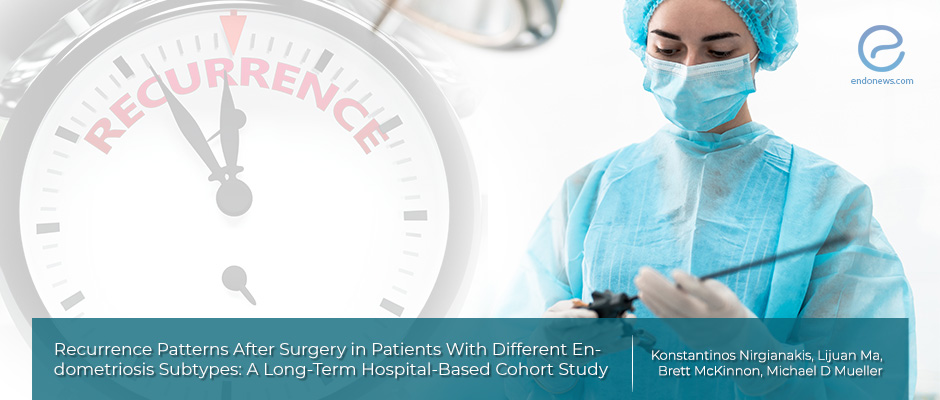Recurrence following surgery for subtypes of endometriosis
Apr 24, 2020
All subtypes of endometriosis are prone to recur with increasing severity despite complete surgical excision.
Key Points
Highlights:
- Endometriosis is prone to recur over the time after the first surgery, regardless of the subtype.
Importance:
- The women with all types of endometriosis who will undergo surgical excision should be informed about the possibility of recurrence.
What’s done here?
- This article was conducted to determine the subtypes of recurrent endometriosis in the subsequent operation in comparison to the initial lesions, and the time to recurrence.
- The women with any type of endometriosis who underwent at least one surgery at the University of Bern from 1997 to October 2018 were included in this retrospective hospital-based cohort study.
- The diagnosis of endometriosis was confirmed by observation during surgery or histopathological examination.
- Patients with an undefined surgical technique, or who had undergone an only diagnostic surgical procedure, or incomplete removal were excluded from the study.
- Women with recurrent endometriosis based on symptoms, clinical suspicion, or imaging were not included.
- The subtypes of endometriosis which are peritoneal endometriosis, ovarian endometrioma, and deep infiltrating endometriosis in both the initial and subsequent surgeries were recorded and analyzed.
- The patient who had a necessity for reoperation after full surgical excision was defined as recurrence and this elapsed time was called the time to recurrence.
Key results:
- A total of 322 patients who underwent surgical excision among 1332 patients having surgically confirmed endometriosis met the criteria.
- The median time to the first recurrent operation in peritoneal endometriosis, ovarian endometrioma, and deep infiltrating endometriosis were 30.5 months, 30 months and 36 months, respectively.
- There was no statistically significant difference regarding time to recurrence between patients who had different subtypes of endometriosis.
- All patients with any subtype of endometriosis had a tendency to recur with the same subtype. For example, women who had undergone surgical removal of ovarian endometrioma had a higher risk for the development of recurrent ovarian endometrioma.
- However, the patients having peritoneal endometriosis and ovarian endometrioma initially had a progression for the more severe subtype of endometriosis which was deep infiltrating endometriosis at recurrence.
Strengths and Limitations
- The strength of the study is that it is the first study to identify the time to recurrence comparing different subtypes of endometriosis.
- The long duration of follow-up and inclusion of patients operated only in a single-center confirmed by surgery were included, add more value.
- Lack of data about postoperative hormonal medication and the possibility of exclusion of undiagnosed recurrent cases are the limiting factors for this study.
Lay Summary
Endometriosis is a disease identified by the location of endometrial stromal and glandular cells outside the uterine cavity. It is considered as a gynecological disease of reproductive-aged women.
Three subtypes of endometriosis are peritoneal endometriosis which defines the endometriotic lesions located on the peritoneal surface, ovarian endometrioma which are the cysts with chocolate-like content located in the ovaries, and deep infiltrating endometriosis which defines the endometriotic lesions situated more than 5 mm deep to the peritoneum.
There are several treatment modalities including expectant management, medical and surgical treatment. The decision for treatment should be patient-centered considering the patient’s clinical presentation, age, the severity of symptoms, disease extent and location, reproductive desire, other comorbidities, side effects and complications related to medical treatment and surgery, and cost.
Laparoscopic excisional surgery results in favorable outcomes regarding the recurrence of disease and symptoms, and obstetric outcomes. However, an important point during operation is the preservation of the ovarian reserve and minimizing postoperative adhesion formation, especially in women with endometriomas. Recurrence is another major concern despite all the advances in methods.
Although many theories have been proposed, the underlying cause of recurrence has not been exactly known. A significant number of patients with endometriosis need subsequent operations due to recurrence after the initial surgery.
Nirgianakis et al, a group of scientists from Switzerland, published a study titled “Recurrence Patterns after Surgery in Patients with Different Endometriosis Subtypes: A Long-Term Hospital-Based Cohort Study” in the "Journal of Clinical Medicine'.
The authors aimed to investigate the recurrence patterns of endometriosis in subsequent operations comparing with the initial operations and determine the time to recurrence comparatively in different endometriosis subtypes. 322 patients with any type of endometriosis who had undergone at least two surgical excision procedures at a single tertiary center were included. The patient who had a necessity for reoperation after full surgical excision was defined as recurrence and this elapsed time was called the time to recurrence.
There was no statistically significant difference regarding time to recurrence between patients who had different subtypes of endometriosis. All patients with any subtype of endometriosis had a tendency to recur with the same subtype. For example, women who had undergone surgical removal of superficial peritoneal endometriosis had a higher risk for the development of recurrent superficial peritoneal endometriosis. However, the patients having superficial peritoneal endometriosis and ovarian endometrioma initially had a progression for the more severe subtype of endometriosis which was deep infiltrating endometriosis at recurrence.
“The results of the study will help clinicians to better comprehend the evolution of endometriosis in recurrent surgeries and ultimately provide valuable information for patient counseling, especially after surgery.” the authors concluded.
Research Source: https://pubmed.ncbi.nlm.nih.gov/32054117/
recurrence progression superficial peritoneal endometriosis endometrioma deep infiltrating endometriosis laparoscopy time to recurrence

